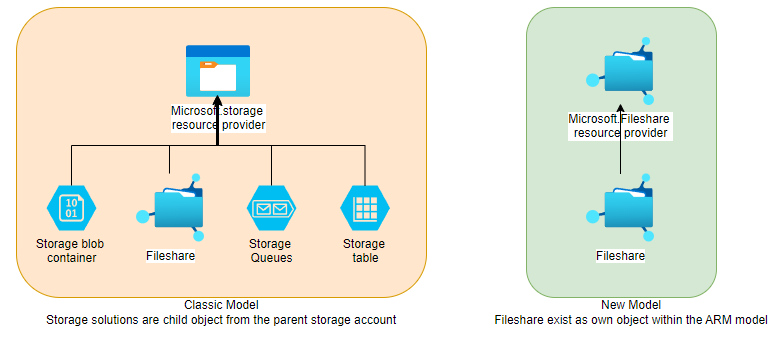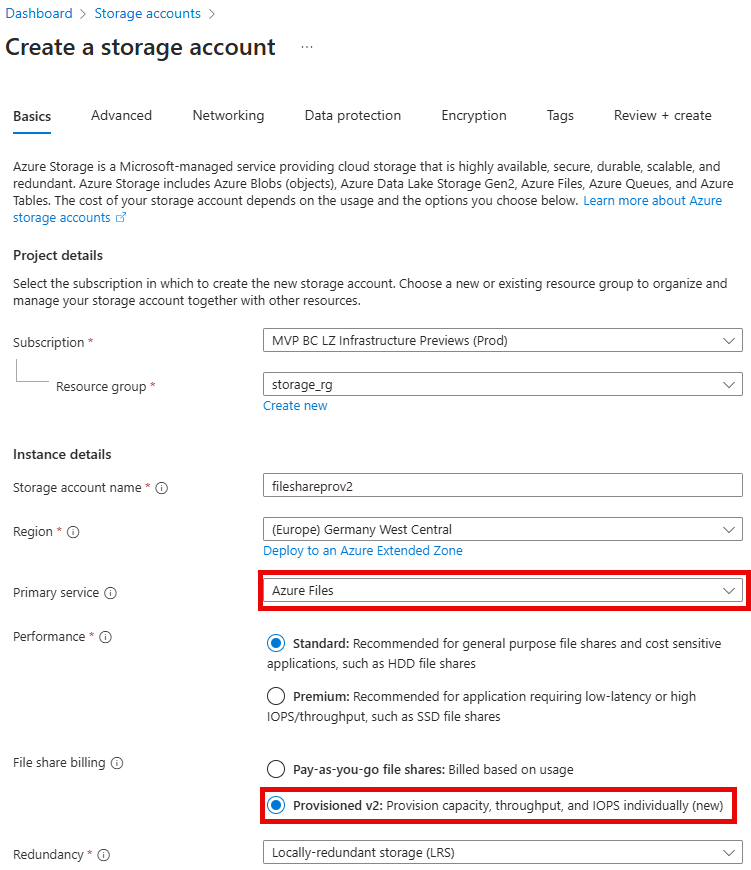As of now Fileshares and other storage services like Blog stroage are based on the pre-date ARM model. For this core storage services there was a predinfed boundardy which is the storage account. This means that other resources as blobs exist as child objects below the storage account. This give some limitation to the child objects, because the Storage account represent a shared pool of storage, IOPS, throughput and more and the child objects must be within these limits.
To solve this problem Microsoft introduced a new management experience for Azure Files that will align the needs for Fileshares. A Fileshare can deployed directly now, without deploying a underlying storage account. See picture one for a graphical architecture

Benefits
- provisioned v2 model enables to dynamically scale up or down application’s performance as needed, without downtime
- can span from 32 GiB to 256 TiB in size
- up to 50,000 IOPS and 5 GiB/sec throughput
- monitoring down to the file share level
Technical specifications
The new Fileshare solution have some different technical specifications compared to the classic approach:
Billing
In the classic model (v1) you pay per use, i.e. you pay for the capacity used and the transactions on the files. But you do not pay for IOPS or throughput, as this is integrated into the offer.
The new Fileshare model is based on pay per use on the three pillars:
- Provisioned storage = €0.0092* per provisioned GiB per month
- Provisioned IOPS = €0.0505* per provisioned IO per sec per month
- Provisioned throughput = €0.0750* per provisioned MiB per sec per month
*Prices at the time of article release for Azure Region West Europe
Billing examples
To give you an overview about what you can save with a migration, I put in an example from a current customer who is using AVD profileshares currently on Storage Account v1 (and you are right mosthly recommendation is to use Premium Fileshares for those solution, but it is a small AVD environment).
| 250GB used capacity | HDD Pay-as-you-go (LRS | Transaction optimized) | HDD Pay-as-you-go (LRS | Transaction optimized) |
| Capacity price | 14,39 | 2,33€ |
| Write transactions x 200.000 | 0,29 | free of charge |
| List transactions x 200.000 | 0,29 | free of charge |
| Read transactions x 200.000 | 0,03 | free of charge |
| Other transactions x 10.000 | 0,01 | free of charge |
| Available/Provisioned IOPS (500) per month | ||
| Maximum throuhgput | ||
| Total cost | 55,98 |
Deployment
The Deployment of the new Fileshare solution is quite easy and can be done via the Portal or automated via IaC. Actual you will start continue to use Storage account. In the „Basics“ blade you will select as Primary Service „Azure Files“ and as File Share billing the new option „Provisioned v2„.

After the creation of the new Fileshare account is done. Go to the acccount itself there you will on the left side see that the options Containers, Queues and Tables are not available as in the v1 variant.

Create a new Fileshare under Fileshare. In the new windows which will be opened you can setup the name and as manual setting the needed IOPS and throughput per Fileshare.
Limitations
In the first couple of days after release there where some regions not available, but this will be solved in the next couple of days. As of now I doesn`t see any limitations in terms of using the new solution.
Before we dive into the new solutions and how they can deployed, let us take a look at the current limitation to see if this solution suitable for you.
Following features are planned and not available yet:
- Zone redundant (ZRS)
- Geo-zone redundant (GZRS)
Migration
Current there are no options available to migrate a v1 storage account automatically to a v2 variant. Best way is to setup the new v2 variant side by side to the existing share and use robocopy /mir to move the folders and files to the new account.
I will extend this section in the next couple of weeks with additional information which is the best way to move existing Fileshare to the new v2 SKU.